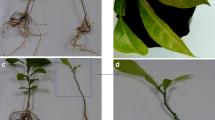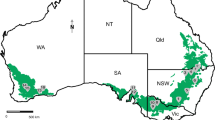Abstract
Fusarium wilt, caused by Fusarium oxysporum f. sp. dianthi (Fod), is the most important carnation disease worldwide. The knowledge of the diversity of the soil population of the pathogen is essential for the choice of suitable resistant cultivars. We examined the genetic diversity of Fod isolates collected during the period 1998–2008, originating from soils and carnation plants in the most important growing areas in Spain. Additionally, we have included some Fod isolates from Italy as a reference. Random amplified polymorphic DNA (RAPD) fragments generated by single-primer PCR were used to compare the relationship between isolates. UPGMA analysis of the RAPD data separated Fod isolates into three clusters (A, B, and C), and this distribution was more related to aggressiveness than to the race of the isolates. The results obtained in PCR amplifications using specific primers for race 1 and race 2, and SCAR primers developed in this work, correlated with the molecular groups previously determined from the RAPD analysis, and provided new molecular markers for the precise identification of the isolates. Results from successive pathogenicity tests showed that molecular differences between isolates of the same race corresponded with differences in aggressiveness. Isolates of races 1 and 2 in cluster A (R1I and R2I isolates) and cluster C (R1-type isolates) were all highly aggressive, whereas isolates of races 1 and 2 in cluster B (R1II and R2II isolates) showed a low aggressiveness profile. The usefulness of the molecular markers described in this study has been proved in double-blind tests with Fod isolates collected in 2008. Results from this work indicate a change in the composition of the Spanish Fod population over time, and this temporal variation could be related to the continuous change in the commercial carnation cultivars used by growers. This is the first report of genetic diversity among Fod isolates in the same race.






Similar content being viewed by others
References
Aloi, C., & Baayen, R. P. (1993). Examination of the relationships between vegetative compatibility groups and races in Fusarium oxysporum f. sp. dianthi. Plant Pathology, 42, 839–850.
Alves-Santos, F. M., Martínez-Bermejo, D., Rodríguez-Molina, M. C., & Diez, J. J. (2007). Cultural characteristics, pathogenicity and genetic diversity of Fusarium oxysporum isolates from tobacco fields in Spain. Physiological and Molecular Plant Pathology, 71, 26–32.
Anonymous (2006). Anuario de estadística agroalimentaria (Cap. 12, 1–13). Spain: Ministerio de Agricultura Pesca y Alimentación.
Baayen, R. P., van Dreven, F., Krijger, M. C., & Waalwijk, C. (1997). Genetic diversity in Fusarium oxysporum f. sp. dianthi and Fusarium redolens f. sp. dianthi. European Journal of Plant Pathology, 103, 395–408.
Campbell, C. L., & Madden, L. V. (1990). Introduction to plant disease epidemiology (p. 532). New York: Wiley.
Chiocchetti, A., Bernardo, I., Daboussi, M. J., Garibaldi, A., Gullino, M. L., Langin, T., et al. (1999). Detection of Fusarium oxysporum f. sp. dianthi in carnation tissue by PCR amplification of transposon insertions. Phytopathology, 89, 1169–1175.
Daboussi, M. J., Langin, T., & Brygoo, Y. (1992). Fot1, a new family of fungal transposable elements. Molecular and General Genetic, 232, 12–16.
Ferguson, L. M., & Carson, M. L. (2007). Temporal variation in Setosphaeria turcica between 1974 and 1994 and origin of races 1, 23 and 23 N in the United States. Phytopathology, 97, 1501–1511.
Gale, L. R., Katan, T., & Klister, H. C. (2003). The probable center origin of Fusarium oxysporum f. sp. lycopersici VCG 0033. Plant Disease, 87, 1433–1438.
Garibaldi, A. (1977). Race differentiation in Fusarium oxysporum f. sp. dianthi and varietal susceptibility. Acta Horticulturae, 71, 97–101.
Garibaldi, A. (1983). Resistenza di cultivar di garofano nei confronti di otto patotipi di Fusarium oxysporum f. sp. dianthi (Prill. et Del.) Snyd et Hans. Riv. Hortoflorofrutt. Italiana, 67, 261–270.
Garibaldi, A., & Gullino, M. L. (1987). Fusarium wilt of carnation: present situation, problems and perspectives. Acta Horticulturae, 216, 45–54.
Jiménez-Gasco, M. M., Pérez-Artés, E., & Jiménez-Díaz, R. M. (2001). Identification of pathogenic races 0, 1 B/C, 5 and 6 of Fusarium oxysporum f. sp. ciceris with random amplified polymorphic DNA (RAPD). European Journal of Plant Pathology, 107, 237–248.
Kalc Wright, G. F., Guest, D. I., Wimalajeewa, D. L. S., & Van Heeswijck, Y. R. (1996). Characterization of Fusarium oxysporum isolated from carnation in Australia based on pathogenicity, vegetative compatibility and Random Amplified Polymorphic DNA (RAPD) Assay. European Journal of Plant Pathology, 102, 451–457.
Kerényi, Z., Táborhegyi, E., Pomázi, A., & Hornok, L. (1997). Variability amongst strains of Fusarium poae assessed by vegetative compatibility and RAPD polymorphism. Plant Pathology, 46, 882–889.
Kolmer, J. A. (1989). Virulence and race dynamics of Puccinia recondita f. sp. tritici in Canada during 1956–1978. Phytopathology, 79, 349–356.
Langin, T., Capy, P., & Daboussi, M. J. (1995). The transposable element impala, a fungal member of the Tc1-mariner superfamily. Molecular and General Genetic, 246, 19–28.
Leslie, J. F., & Summerell, B. A. (2006). The fusarium laboratory manual (1st ed.). Ames: Blackwell Publishing.
Lori, G., Edel-Herman, V., Gautheron, N., & Alabouvette, C. (2004). Genetic diversity of pathogenic and non-pathogenic populations of Fusarium oxysporum isolated from carnation fields in Argentina. Phytopathology, 94, 661–668.
Migheli, Q., Briatore, E., Daboussi, M. J., & Langin, T. (1997). Differentiation between physiological races of Fusarium oxysporum f. sp. dianthi by pathogenicity assay, random amplification of polymorphic DNA (RAPD) and distribution of Fot1 transposable element. Page 81 in: Abstr. Proc. 19th Fungal Genet. Asilomar Conf., Pacific Grove.
Montarry, J., Glais, I., Corbiere, R., & Andrivon, D. (2008). Does selection by resistant hosts trigger local adaptation in plant-pathogen system potato late blight. Journal of Evolutionary Biology, 21, 1397–1407.
Pérez-Artés, E., García-Pedrajas, M. D., Bejarano-Alcázar, J., & Jiménez-Díaz, R. M. (2000). Differentiation of cotton-defoliating and nondefoliating pathotypes of Verticillium dahliae by RAPD and specific PCR analyses. European Journal of Plant Pathology, 106, 507–517.
Prados-Ligero, A. M., Basallote-Ureba, M. J., López-Herrera, C. J., & Melero-Vara, J. M. (2007). Evaluation of susceptibility of carnation cultivars to Fusarium wilt and determination of Fusarium oxysporum f. sp. dianthi races in southwest Spain. HortScience, 42(3), 596–599.
Sambrook, J., Fritsch, E. F., & Maniatis, T. (1989). Molecular cloning: a laboratory manual (2nd ed.). New York: Cold Spring Harbor Laboratory Press.
Suárez Bonnet, E. (2007). Caracterización racial de Fusarium oxysporum f. sp. dianthi y determinación de su viabilidad en suelos sometidos a distintos regímenes térmicos. PhD Thesis. University of Córdoba: Spain.
Van de Peer, Y., & De Wachter, R. (1994). TREECON for Windows: a software package for the construction and drawing of evolutionary trees for the Microsoft Windows environment. Computer Applications in the Biosciences, 10, 569–570.
Wang, B., Brubaker, C. L., Summerell, B. A., Thrall, P. H., & Burdon, J. J. (2010). Local origin of two vegetative compatibility groups of Fusarium oxysporum f. sp. vasinfectum in Australia. Evolutionary Applications, 3, 505–524.
Windels, C. E. (1992). Fusarium. In L. I. Singleton, J. D. Mihail, & C. M. Rush (Eds.), Methods for research on soilborne phytopathogenic fungi (pp. 115–128). St. Paul: APS Press.
Acknowledgements
This research was supported by grant AGL 2006–03252 from the Spanish Ministry of Science and Innovation. We thank Ana Prados-Ligero and J.M. Melero-Vara for providing the initial collection of F. oxysporum f. sp. dianthi isolates, Emilio A. Cano (Barberet & Blanc S.A.) for providing carnation cultivars, and Rafael Pacheco (Mercado Rivera S.L.) for helping with the inspection and sample collection in the carnation growing areas.
Author information
Authors and Affiliations
Corresponding author
Rights and permissions
About this article
Cite this article
Cabanás, C.GL., Valverde-Corredor, A. & Pérez-Artés, E. Molecular analysis of Spanish populations of Fusarium oxysporum f. sp. dianthi demonstrates a high genetic diversity and identifies virulence groups in races 1 and 2 of the pathogen. Eur J Plant Pathol 132, 561–576 (2012). https://doi.org/10.1007/s10658-011-9901-4
Accepted:
Published:
Issue Date:
DOI: https://doi.org/10.1007/s10658-011-9901-4




